Update: ‘USPS Electric Mail Truck,’ ‘Kia EV5,’ and ‘Blue Arc delivery van’ updated and ‘Ford E-Transit with improved range,’ ‘All-new Ford electric van,’ and ‘Chevrolet Brightdrop 400’ added.
Electrification in the automobile industry extends not just to hatchbacks and lifestyle electric pickup trucks but to commercial vehicles as well. Given that the average delivery van covers less than 160 miles a day, which is well within the reach of current battery technologies, fleet operators and e-commerce majors are transitioning to electric vans, and here are some options.
Tesla Robovan
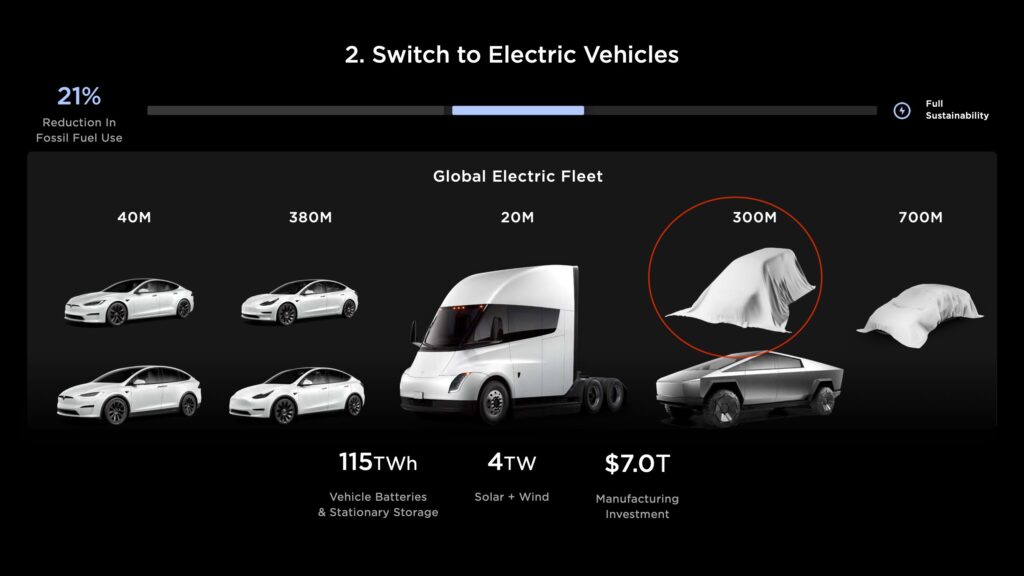
After the Semi and Cybertruck, Tesla’s next large commercial model launch could be a van. On July 7, 2022, Elon Musk, co-founder and CEO, Tesla, asked his Twitter followers if the company should make a ‘Robovan’ that’s highly configurable and used to move people and transport cargo. Maybe Tesla could offer it with an optional solar power canopy that extends both sides and triples the roof area as an option, Musk said in a follow-up post on Twitter a few hours later.
At the 2023 Investor Day, Tesla showed a large boxy vehicle under a cover in a presentation slide. The outline seemed like that of a high-roof vehicle and could very well be the Tesla Robovan.
Tesla has long considered adding a van to its lineup. The company is “definitely” going to make an electric van at some point, Musk said during the Q4 2020 earnings conference call on January 27, 2021. A month later, during The Joe Rogan Experience podcast (listen on Spotify), he said the solar roof of such a model could add around 30 miles of range per day.
Before the Tesla Robovan, the next-gen Tesla Roadster and the Tesla Robotaxi look like priorities. So, Tesla’s electric van could easily be 3-4 years from commercialization. The Master Plan Part 3 (pdf) document Tesla released on April 5, 2023, suggests the company expects the Robovan and the Cybertruck together to record 300 million units in cumulative sales.
USPS Electric Mail Truck
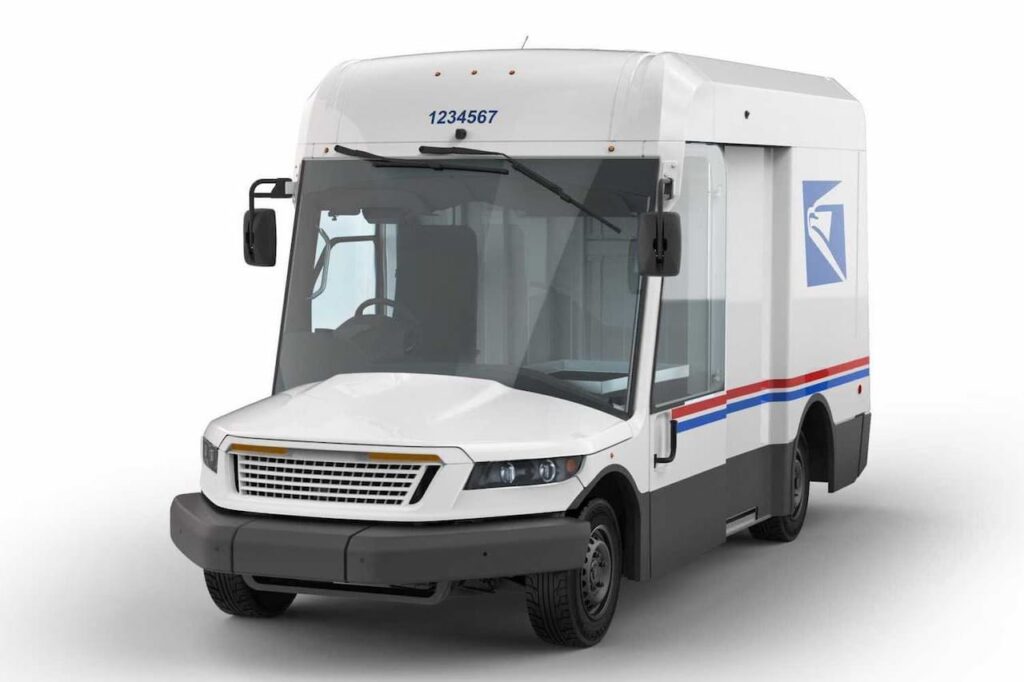

Oshkosh Defense has developed a ‘Next Generation Delivery Vehicle (NGDV)’ for the United States Postal Service (USPS). While new companies like BrightDrop and Rivian are reinventing vans with attractive, futuristic designs, the Oshkosh Corporation subsidiary has done something strange! A duck-billed big box is how we’d describe it!
The Oshkosh NGDV is aimed at not only making delivery operations eco-friendly but also easing them for the carriers. Features like front and rear parking sensors, 360-degree camera system, blind spot warning system, automatic electronic parking brake, airbag, etc. will ensure safety. A surveillance camera will be installed for security, while AC and a walk-in cargo area with cab access will provide the driver comfort and convenience.
The Oshkosh NGDV will be available in an internal combustion engine variant (ICE) and a pure electric variant. There’s no word on the specifications yet, not even targeted figures. Oshkosh Defense manufactures the NGDV in Spartanburg, South Carolina, and it started delivering the ICE variant to USPS on May 31, 2024.
USPS deployed four units of the combustion-engined variant at the Sorting and Delivery Center in Athens, Georgia the same day. In August 2024, the National Association of Letter Carriers (NALC) had said that Oshkosh Defense will manufacture the first units of the all-electric variant and USPS will put them into service the same month.
USPS expects to procure at least 60,000 units of the NGDV, of which a minimum of 45,000 will be electric, by 2028.
Ford E-Transit with improved range
On February 8, 2022, Ford began shipping the E-Transit electric van to customers from its Kansas City Assembly Plant. In the U.S., prices for the E-Transit start at USD 45,995, excluding a USD 1,895 destination fee. The E-Transit became the best-selling electric van in the U.S. in 2022, with 6,500 units delivered. In 2023, sales increased by 18% to 7,672 units, securing its position as the top-selling electric van in the market for a second consecutive year.
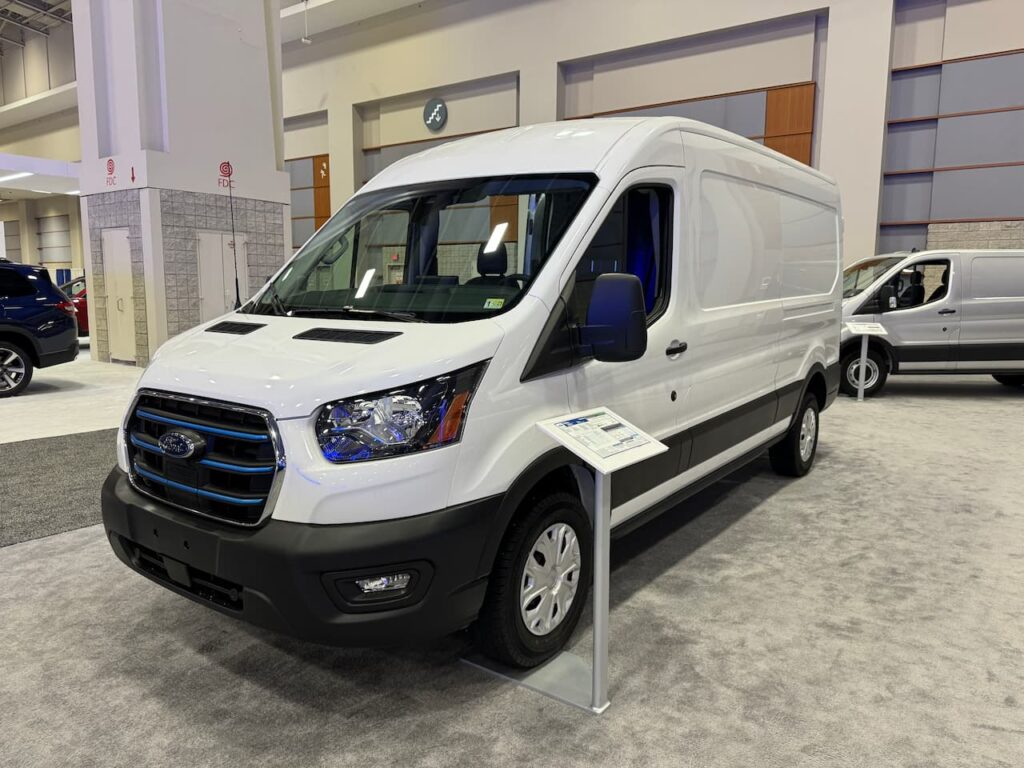

Available in six configurations (three roof heights, three lengths, and as a Cargo Van, Chassis Cab, and Cutaway), the E-Transit uses an 89 kWh lithium-ion battery and a single permanent-magnet motor that produces 198 kW (266 hp) and 317 lb.-ft. of torque. On a full charge, it can cover 159 miles (on the low-roof cargo van configuration).
The Ford E-Transit is America’s best-selling electric van and could see even higher demand with an improvement in the range, a crucial factor for most customers when deciding on their EV. Ford plans to increase the E-Transit’s range by installing new cells manufactured by the BlueOval SK joint venture company’s Plant 1 in Glendale, Kentucky as early as mid-2025. BlueOval SK expects this factory to be ready in the first half of 2025, external affairs director Keli McAlister said in an interview with The Korea Herald on July 17, 2024.
All-new Ford electric van
Ford has announced plans to produce a new electric van at the Ohio Assembly Plant starting in 2026. Initially, it was speculated that this could be the second-generation E-Transit. However, with Ford planning an upgraded version of the current E-Transit for mid-2025, this seems unlikely. The 2026 electric van is expected to target a new segment, expanding Ford’s offerings in the electric van market.
Rivian EDV 900
The Rivian electric van is built on the R1’s skateboard chassis, albeit at a lower cost (using a lot of steel). There are three versions of the Rivian EDV: Rivian EDV 500, Rivian EDV 700, and Rivian EDV 900, named as per their respective load capacities.
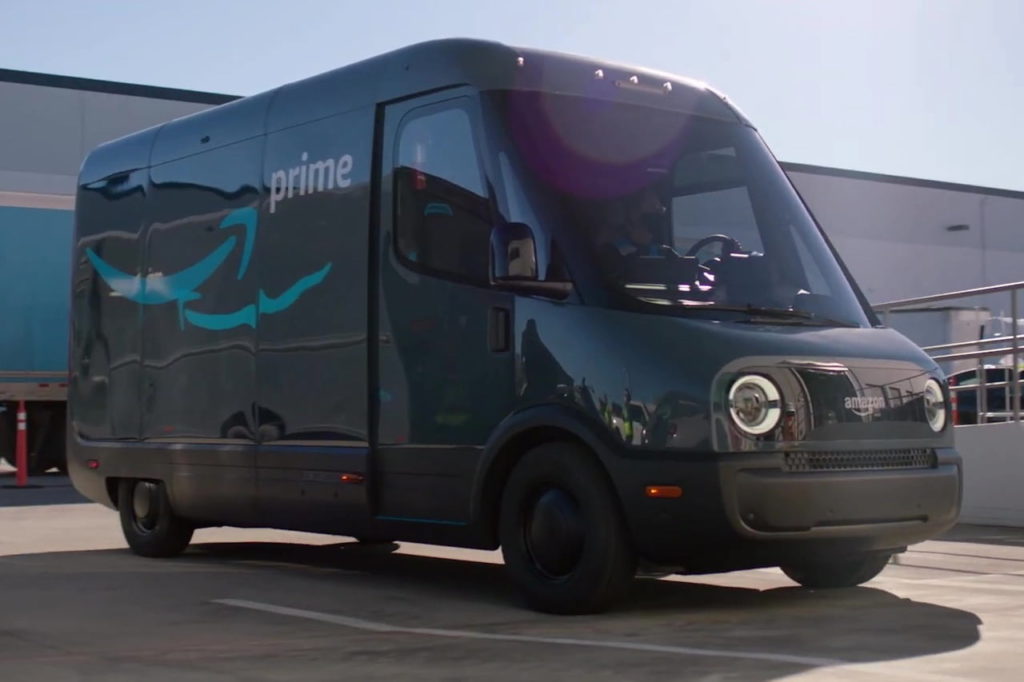

Amazon deployed Rivian-sourced electric delivery vans in the U.S. in the Summer of 2022, and as of July 10, 2024, it has more than 15,000 units of those models on the road. The company uses them in more than 1,800 cities across the country and has delivered more than 260 million packages.
Amazon plans to acquire a total of 100,000 EDVs from Rivian, so a large part of the order is still pending. Rivian has revised its terms & conditions with Amazon so that it can sell commercial vans to other customers, Founder and CEO RJ Scaringe announced during the company’s Q3 earnings conference call on November 7, 2023.
In an SEC filing on October 1, 2021, Rivian had revealed the following specifications of the EDV:
| Aspect\Specification | EDV 500 | EDV 700 | EDV 900 |
| Length | 248 in. | 277 in. | 321 in. |
| Wheelbase | 157 in. | 187 in. | 205 in. |
| Cargo Space | 500 cu. ft. | 660 cu. ft. | 840 cu. ft. |
| GVWR | 9,350 lbs. | 9,350 lbs. | 14,000 lbs. |
| Range | Up to 150 miles | Up to 150 miles | Up to 120 miles |
Rivian has started using an LFP (lithium iron phosphate) battery pack in the EDV, which has helped it reduce cost and maybe even improve supply stability. “In the case of our commercial vans, 100% of the commercial vans are moving to LFP pack configuration,” RJ Scaringe, Founder, Chairman, and CEO of Rivian, said during the company’s Q1 2023 earnings conference call on May 9, 2022.
Rivian Commercial Van
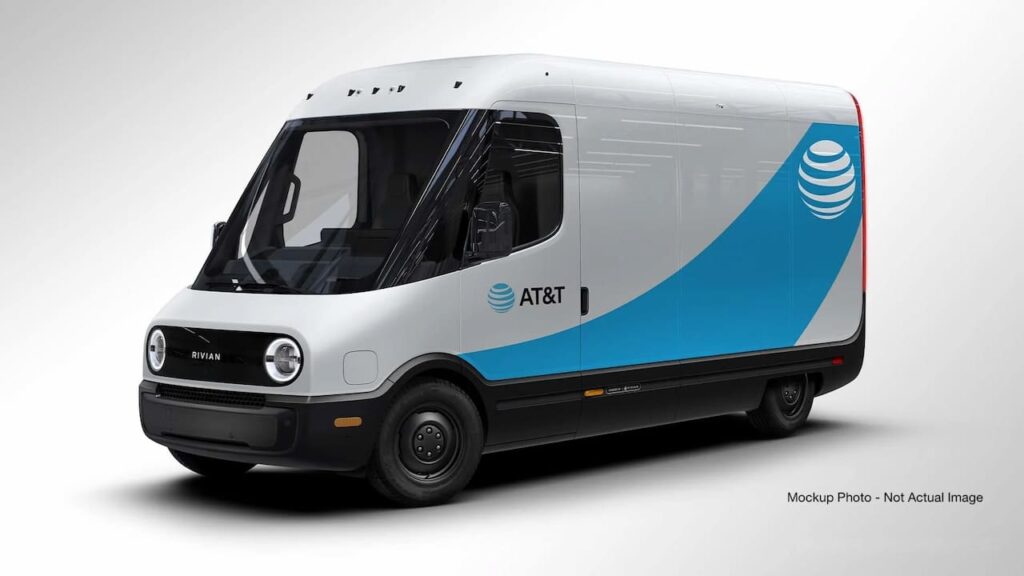

Following the aforementioned change in the agreement with Amazon, Rivian has released a modified version of the Electric Delivery Van (EDV) for other customers, simply called ‘Commercial Van.’ The Rivian Commercial Van features LED headlights, a curbside sliding door, a 15.6-inch central touchscreen, two wireless charging pads, a 360-degree camera system, three airbags, automatic emergency braking, and various advanced driver assistance systems.
The Rivian Commercial Van is available in 500 and 700 versions, which are equivalent to the Amazon EDV’s 500 and 700 versions. The Rivian Delivery 500 Commercial Van has a gross vehicle weight rating of 9,350 lbs. and a payload capacity of 2,734 lbs. Rivian estimates it can travel up to 161 miles on a full charge.
The Rivian Delivery 700 Commercial Van has a higher gross vehicle weight rating of 9,500 lbs. but a lower payload capacity of 2,513 lbs. The 700 version’s advantage over the 500 version is a significantly bigger cargo area. Its estimated range is slightly lower – 153 miles.
| Aspect | Rivian Delivery 500 Commercial Van Specification | Rivian Delivery 700 Commercial Van Specification |
| Length | 248.5 in. | 278 in. |
| Width (incl. mirrors) | 96.4 in. | 103.5 in. |
| Height | 114.7 in. | 114.8 in. |
| Wheelbase | 157.5 in. | 187 in. |
| Ground Clearance | 6.9 in. | 6.9 in. |
| GVWR | 9,350 lbs. | 9,500 lbs. |
| Payload Capacity | 2,734 lbs. | 2,513. |
| Drivetrain Layout | FWD | FWD |
| Rivian-est. Range | 161 mi | 153 mi |
The Rivian Commercial Van is priced at USD 83,000 for the 500 version and USD 87,000 for the 700 version. Rivian indicates that both the Delivery 500 Commercial Van and Delivery 700 Commercial Van could be eligible for a federal tax credit of up to USD 7,500. Deliveries were to commence in early 2024 on a limited scale.
Chevrolet Brightdrop 400
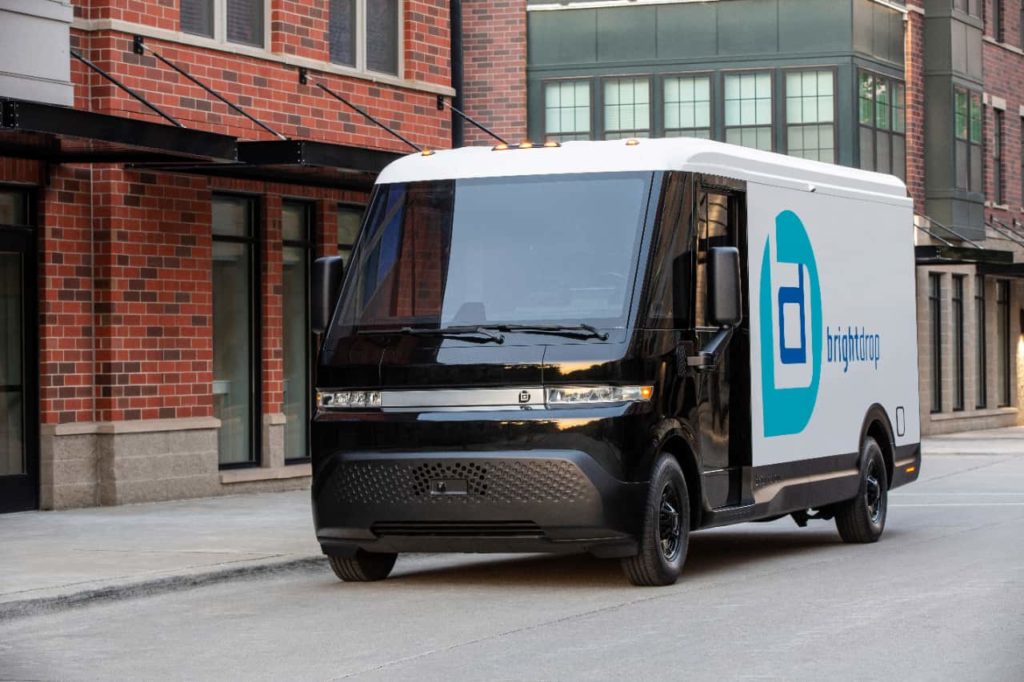

Conceived in GM’s Innovation Lab in January 2021, BrightDrop became part of GM Envolve in November 2023. In August 2024, GM brought the electric commercial van start-up under the Chevrolet brand. All Chevrolet dealers that meet GM’s commercial EV requirements will be able to sell BrightDrop vans. This change benefits customers with a wider availability.
The Chevrolet BrightDrop 400 is designed for smaller and more frequent deliveries, with a length of 238.6 in. long and a wheelbase of 153.1 in. Its cargo area measures 117.51 in. in length, 83.68 in. in width, and 82 in. in height and offers 412.1 cu. ft. of space. It has a maximum payload capacity of up to 3,580 lbs. and a GVWR of up to 11,000 lbs.
The Chevrolet BrightDrop 400 is based on a dedicated EV platform and uses GM’s Ultium battery technology and drive technology (the same technology found on its passenger vehicles). It is available in a FWD variant with 240 hp and 300 lb.-ft. of torque and an AWD variant with 300 hp and 390 lb.-ft. of torque. As standard, delivers a range of 159 miles in both variants, but with a bigger battery pack available in the AWD variant, it can travel up to 272 miles.
Production of the Chevrolet BrightDrop 400 takes place alongside the Chevrolet BrightDrop 600 at GM’s CAMI Assembly Plant in Ingersoll (Ontario), Canada. On June 30, 2022, former BrightDrop President and CEO Travis Katz told Bloomberg that the company plans to have an annual production capacity of more than 50,000 EVs at this plant by 2025. The Zevo 400 was also part of the interaction, with Katz saying that this is a great vehicle, particularly for uses like grocery delivery, where customers do shorter runs for delivering all the packages.
Mercedes premium vans
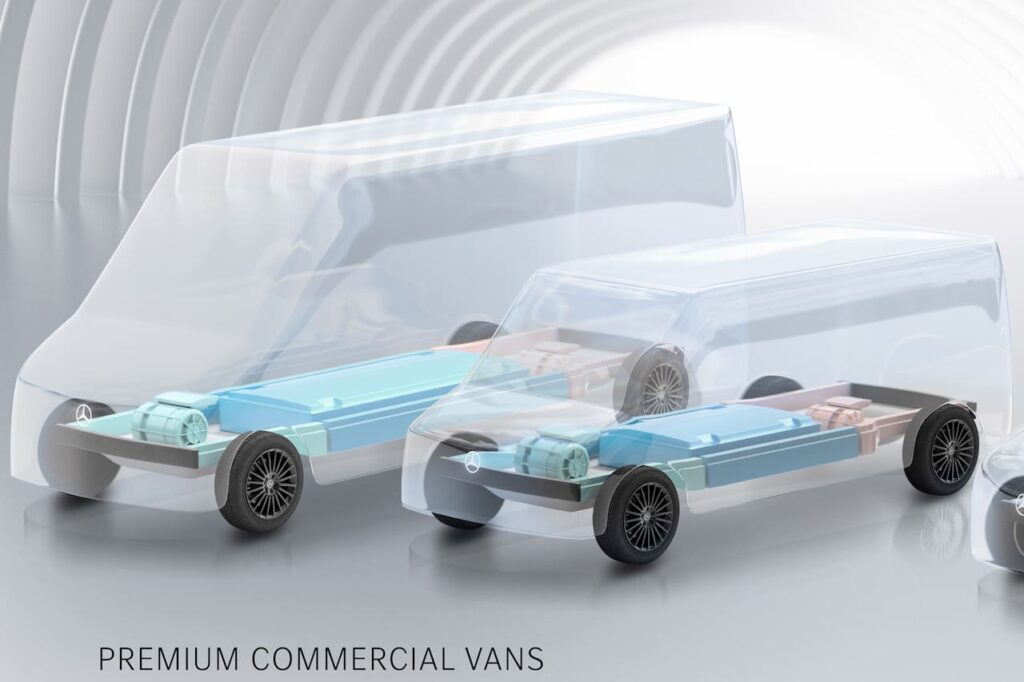

Mercedes-Benz Vans has confirmed new pure-electric premium commercial vans in the mid-size and large segments. The company will build the electric commercial vans on a new VAN.EA-C platform, tailor-made for various configurations and applications. The upcoming platform will be designed and engineered from the ground up for purpose-built electric vehicles. The dedicated approach ensures that the vans using this platform will offer superior spaciousness and efficiency compared to electric vans that employ modified internal combustion engine (ICE) vehicle platforms.
Running MB.OS vehicle software, the new electric Mercedes vans for commercial use will be highly digital. They will support SAE Level 2 autonomous driving right from launch. Mercedes-Benz Vans plans to begin offering SAE Level 4 autonomous driving in them by 2030. Courier, express and parcel delivery (CEP) operators, hospitals, roadside assistance companies, and many other service providers will find the new electric Mercedes vans suitable for their work.
The first electric Mercedes premium van for commercial use will likely be launched in 2025.
Kia PV5
The Kia PV5, already previewed in a concept version, will be the brand’s first purpose-built vehicle, designed and engineered to run on electric power from the ground up. It will be a mid-size purpose-built vehicle designed for businesses like urban passenger mobility and cargo transportation. Scheduled to arrive in mid-2025, it will be available in Basic (passenger), Van (delivery), High Roof (delivery), and Chassis Cab versions.
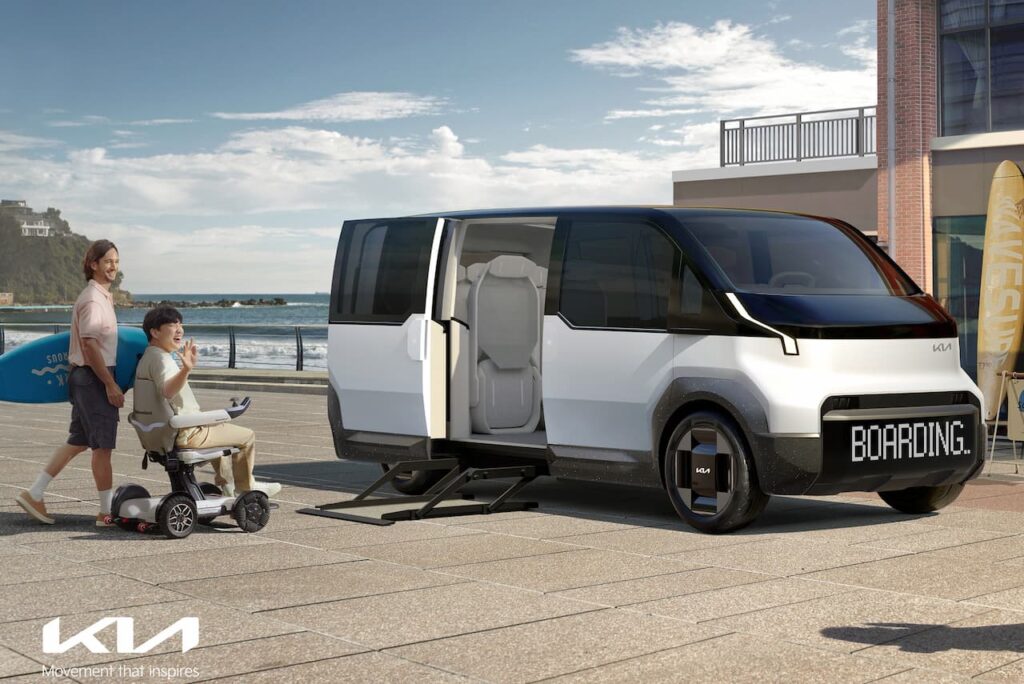

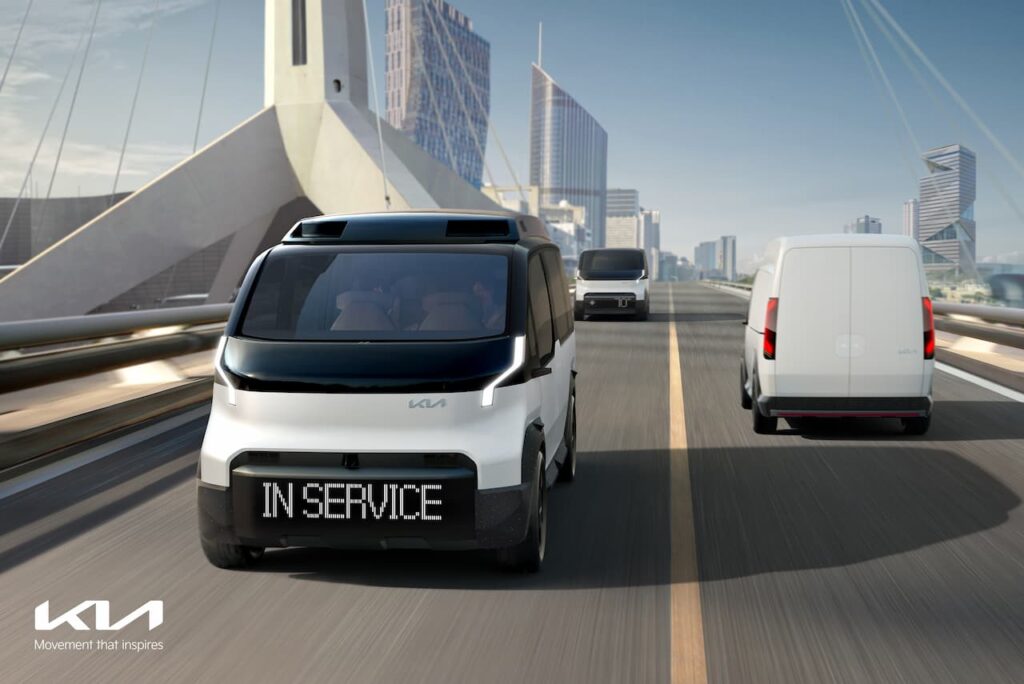

The PV5 will have a modern exterior with angular vertical DRLs, discreetly placed headlamps, aero wheels, etc. The model will feature OTA (Over the Air) and FoD (Feature on Demand) services.
The passenger version should have a minimalist interior and offer easy ingress/egress through large sliding doors. We expect it to feature a dashboard that looks like a sleek, desk-like surface, a compact steering wheel, and a freestanding portrait touchscreen infotainment system. Spy shots (via YouTube) have revealed that it features A-pillar grab handles and light-bronze colorerd seatbelts. The large windows should give the driver a pretty good view of the surroundings.
The Kia PV5 will sit on an ‘eS’ platform, a part of Hyundai Motor Group’s Integrated Modular Architecture (IMA) system, an EV skateboard developed exclusively for PBVs. The Kia SW PBV will be able to travel up to 600 km (373 miles) on a single charge. It will have a 1.8 m (5.9 ft.) indoor height.
Kia will manufacture the mid-size PBV at a dedicated factory in the Autoland Hwaseong production facility in Hwaseong-si, Gyeonggi-do, South Korea. The company will begin mass production in the second half of 2025. It plans to produce 150,000 PBVs in the first full year. A Robo-Taxi version capable of Level 4 autonomous driving will follow, likely featuring a LiDAR on its roof.
Kia PV7
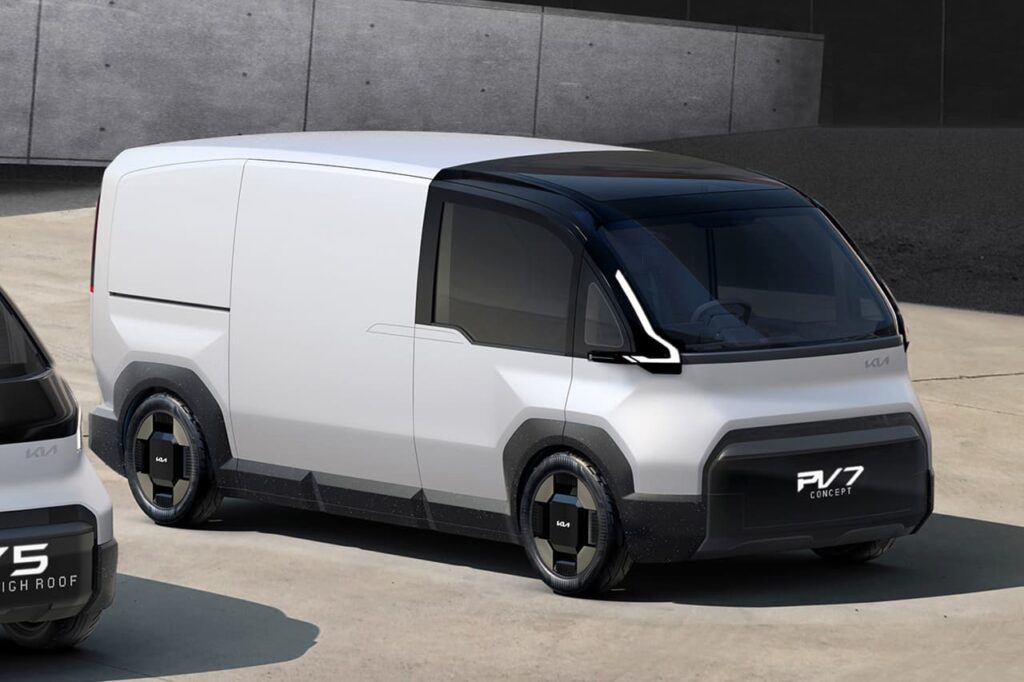

The Kia PV7 will be a large cargo delivery and multi van measuring around 207.5 inches in length, 81.3 inches in width, and 83.5 inches in height and having a wheelbase of approximately 133.5 inches. Customers will be able to use it as a people mover shuttle, mobile store/office van, delivery van, refrigerated van, and more. The large electric van will arrive after the mid-size model explained above.
Large logistics or distribution companies, shuttle service providers, ride-hailing service providers, small business owners, and contract drivers will find the PV7 attractive because of its spacious and versatile interior.
The Kia PV7 should also roll out of the same new dedicated PBV plant in Hwaseong, South Korea. Kia should also set up an exclusive dealer network for commercial vehicles in almost every market where it plans to sell vans. John Hargreaves told Fleet News that Kia would need to establish a dealer network for after-sales coverage. Hargreaves is the company’s manager for fleet and remarketing in the UK, where the plan appears to involve the launch of a range of vans and a wide dealer network offering sales and service.
Blue Arc delivery van
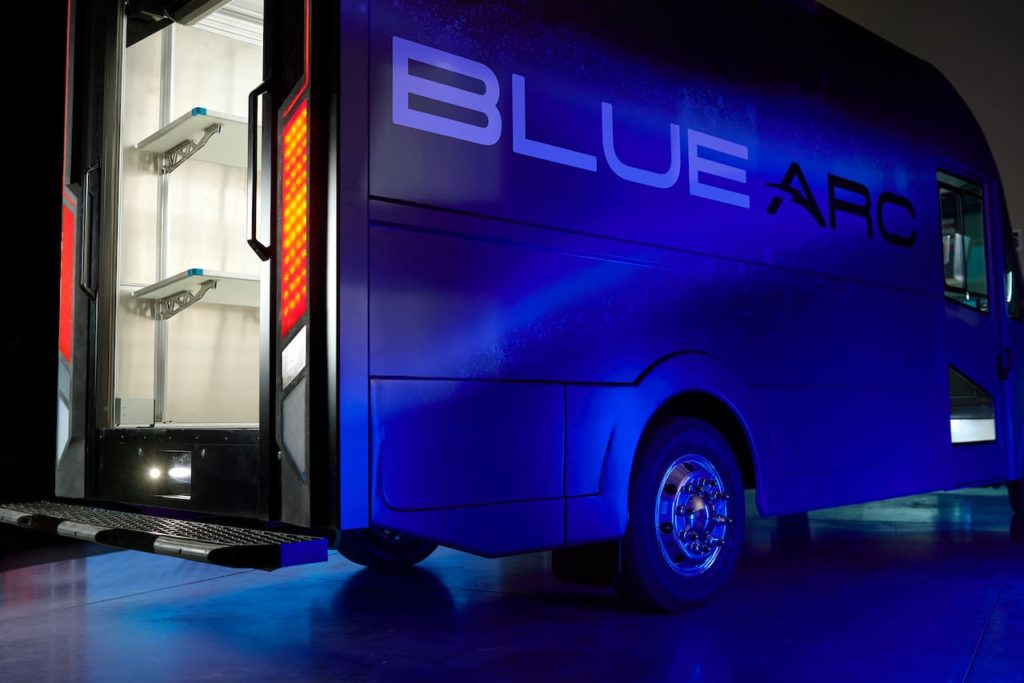

Michigan-based The Shyft Group, formerly Spartan Motors, launched its EV brand Blue Arc on March 9, 2022. Among the confirmed products is a walk-in delivery van designed for high-frequency, last-mile delivery fleets.
The Blue Arc van offers 635-800 cubic feet of cargo space and a payload of up to 5,000 lbs. Its battery capacity ranges from 160-240 kWh with 800V system voltage, and at least one configuration provides a 150-mile range. An optional solar roof generates 1-2 kW. The van’s scalable chassis design (Class 3-5) varies in length from 12 to 22 feet.
Key features include a 360-degree camera system, HD camera displays, automated entry, lane departure, and parking sensors.
Shyft Group received CARB approval for its Class 3-5 Blue Arc EVs. The Class 3 Blue Arc EVs have a city range rating of 225 miles, while the EPA gives the Class 3 model with a 165 kWh battery a 200-mile range and 45 MPGe.
Former Shyft Group CEO Daryl Adams told Reuters that the company planned to build 200 units by the end of 2022, ramping up to 2,500 units by 2025. On October 26, 2023, during the Q3 earnings call, CFO Jon Douyard announced a delay in deliveries to 2024 due to battery issues. Production will take place in Charlotte, Michigan.
On September 13, 2022, Shyft Group announced that Randy Marion Automotive Group, one of the largest car dealerships in the Carolinas, has placed a pre-order for 2,000 Blue Arc electric delivery walk-in vans. Back then, the company expected to kick off sales in mid-2023. On, May 2, 2024, the company announced that FedEx has also ordered 150 units, after conducting a pilot on 8-10 hour routes under challenging conditions, including hot weather ranging from 95ºF to 105ºF. It continues expecting to begin deliveries in late 2024.

A Mechanical Engineer by qualification, I started out as an automotive editor of a regional magazine in 2011. In my 11 years of experience in creating automotive content, I’ve traveled around the world to review, analyze and report on the world’s top electrified cars.
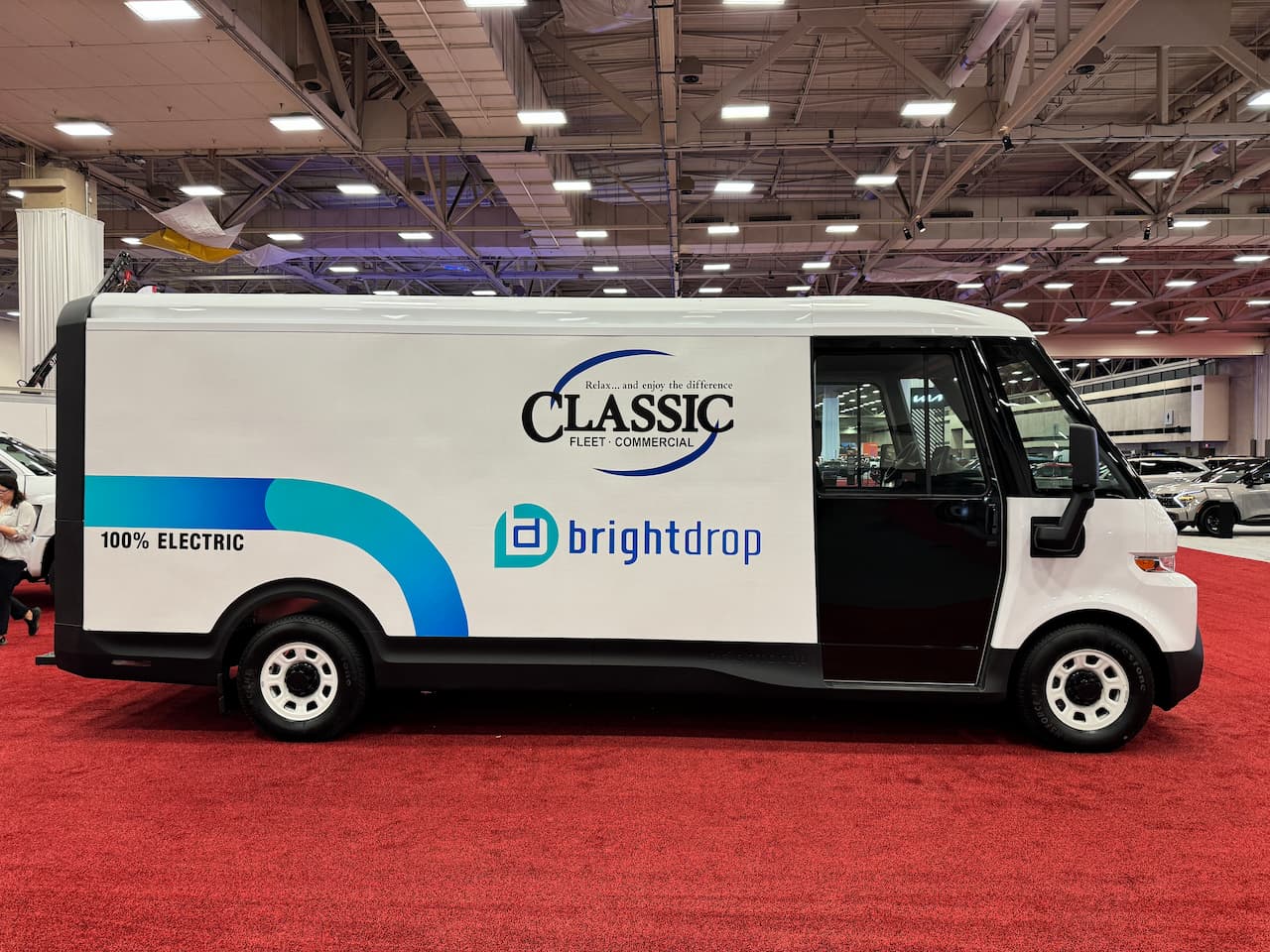
Comments are closed